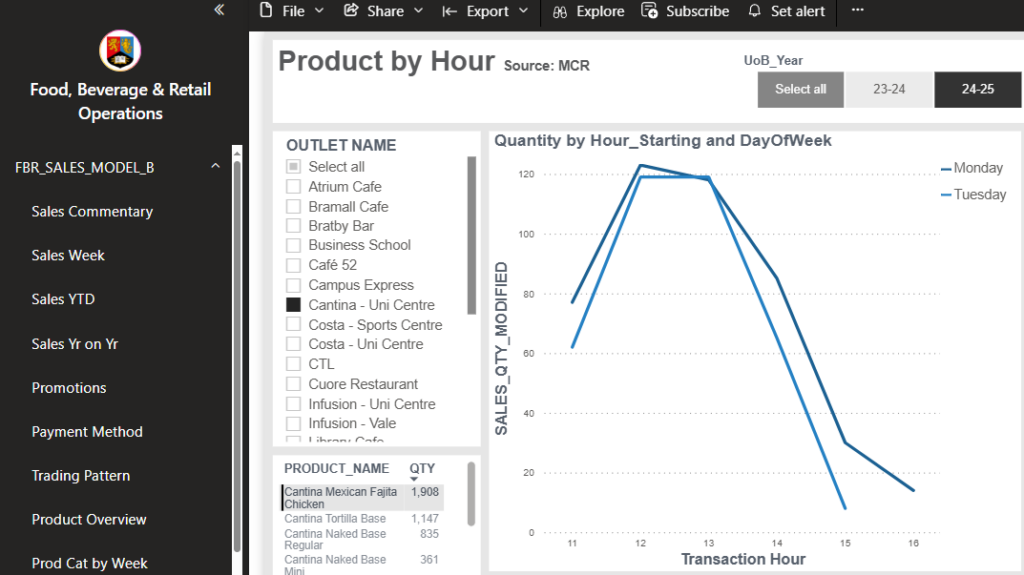University success isn’t just about lectures and labs; it’s also about creating a vibrant campus environment. Good food and drink, offered in welcoming spaces, are absolutely vital. These aren’t just places to eat; they’re hubs for collaboration, where ideas spark and connections form—all essential elements in developing great teaching, learning, and research.
A valuable dataset
Most people might not realise it, but every time you grab a coffee or a sandwich on campus, you’re contributing to a massive digital footprint. Our food and beverage outlets generate an astonishing 40,000 transactions a week, translating to 1.5 million transactions each year! This data, recorded in our databases, tells us a tremendous amount about what’s being purchased, where, and when.
This hidden wealth of information can drive significant service improvements. Recognising this potential, the University’s IT Innovation team partnered with Campus Services team to explore how we could harness this transactional data for both operational and strategic decision-making.
What does the data reveal?
This rich data provides insights into:

- The demand for diverse food and beverage options.
- The popularity of various campus locations.
- The most sought-after items by our customers.
- The peak times our outlets are used.
The case of the missing burritos: A data-driven solution
Imagine the panic at Cantina! “We’ve run out of chicken! How can this be? Did we cook less? No! We must have sold more!”
Alarm bells were ringing. But a quick check of the Power BI dashboard revealed a surprising truth: they had actually sold less than the day before. The simple explanation? Over-portioning.
This seemingly small issue had a big impact: 75 students missed out on a burrito that day. Without the dashboard, such a problem could escalate, potentially leading to over 14,000 burritos going unmade each year—a significant waste and a disservice to our community.

While burritos might be a humorous example, the underlying principle is serious. With over 9,000 staff and 36,000 students from 162 countries, the University has an incredibly dynamic customer base that it needs to understand. Leveraging the data from our 1.5 million annual transactions has the potential to make informed decisions that:
- Better understand customer choices.
- Develop new revenue streams.
- More effectively manage costs.
Ultimately, these insights support our central aim: to create a student-friendly food and beverage service that is diverse, high-quality, affordable, flexible, and clearly communicated.
More than just transactions
Innovation doesn’t always have to be complex. In this case, it’s about gaining better access to high volumes of quality data about our customer buying habits. This allows us to continuously improve the catering offer and custom experience across campus.
And the potential goes even further. While this data is highly transactional, it can be combined with other datasets, such as student timetabling and student attainment. The insights generated could not only improve services but also begin to explore the deeper relationship between food, community, and the quality of teaching, learning, and research.
Building the data foundations
Managing such a vast volume of data quickly requires robust technology. The University is equipped with a modern data platform, powered by Azure Integration Services (AIS) and a Snowflake data warehouse. This infrastructure made the task significantly easier.

The IT Innovation team quickly developed a simple data pipeline in just a few days, capable of handling and storing thousands of data points. Once the data was securely in the University’s data warehouse, campus services’ data analytics experts were able to create intuitive dashboards using Power BI.
What’s next?
The food and beverage teams within our campus services division are now actively using these data and insights to support their daily operations. More broadly, the University is making significant commitments to its data strategy, focusing on using data to drive operations and enhance experiences across the board. The IT Innovation team will continue to seek out and explore opportunities that demonstrate the innovative use of data as a core part of the university’s overall data strategy.
